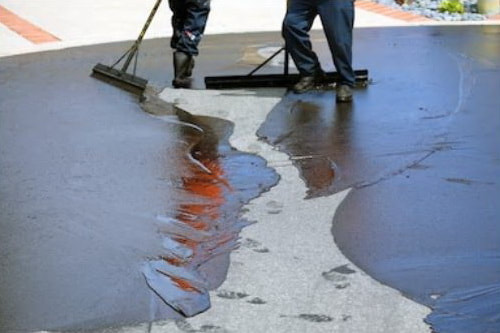Hot Mix Asphalt: A Lasting Service for Pavement
Hot Mix Asphalt (HMA) has actually emerged as a leading lasting option for pavement options, providing a myriad of innovative innovations and environmental advantages. As the need for environment-friendly construction techniques grows, checking out the nuances of HMA's sustainability can supply valuable insights right into the future of pavement remedies.
Environmental Advantages of Warm Mix Asphalt

In Addition, Hot Mix Asphalt aids to reduce city warm island results. Its dark color soaks up sunlight, lowering the amount of warm mirrored back right into the ambience compared to lighter-colored pavements. This can decrease ambient temperatures in metropolitan locations, decreasing the demand for cooling and ultimately decreasing power consumption.
Additionally, Hot Mix Asphalt adds to boosted stormwater monitoring. Its porous nature allows water to infiltrate the pavement and charge groundwater products, lowering drainage and the threat of flooding. These ecological advantages make Warm Mix Asphalt a lasting selection for leading roadways and freeways.
Energy Effectiveness in HMA Production
Is energy efficiency a critical variable in the manufacturing of Hot Mix Asphalt (HMA)? Power plays a significant function in the production of HMA, influencing both expense and environmental sustainability. One vital element of energy performance in HMA production is the usage of warm mix asphalt (WMA) technologies.
In addition, improvements in plant modern technologies have caused more energy-efficient HMA manufacturing processes. Modern plants are created with functions like recycled asphalt sidewalk (RAP) handling capabilities, efficient heater systems, and improved insulation, all adding to energy financial savings. By optimizing power usage in HMA manufacturing, the industry can minimize its carbon impact while preserving high-quality sidewalk products. Energy effectiveness is, therefore, a critical consideration in making certain the sustainability of Hot Mix Asphalt manufacturing.
Recyclability of Warm Mix Asphalt
The recyclability of Hot Mix Asphalt (HMA) is a critical element of its sustainability and lasting environmental impact. HMA is among one of the most recycled products in the USA, with over 100 million lots of recovered asphalt sidewalk (RAP) being recycled annually in new pavement building. Reusing HMA supplies numerous environmental benefits, such as decreasing the requirement for virgin products, reducing power usage throughout manufacturing, and lowering the amount of waste sent to landfills.
The process of recycling HMA includes grating the existing pavement, crushing it into smaller pieces, and mixing it with new aggregate and asphalt binder to create a recycled mix. This recycled mix can frequently execute as well as or even far better than traditional HMA, while needing fewer raw materials and producing lower greenhouse gas emissions. By incorporating RAP right into brand-new sidewalk jobs, road companies can conserve natural sources, lower prices, and lessen the environmental footprint of road construction and upkeep tasks. Check This Out Generally, the recyclability of HMA plays a considerable function in advertising sustainable practices within the sidewalk sector.

Long-Term Efficiency of HMA
Asphalt sidewalks show longevity and resilience over an extended period, reflecting the long-term performance of Warm Mix Asphalt (HMA) The longevity of HMA can be attributed to its ability to withstand rush hour loads, harsh climate condition, and the results of aging. Researches have actually revealed that properly designed and appropriately built HMA pavements can last for 20 years or even more with normal upkeep. The secret to optimizing the long-lasting performance of HMA hinges on using high-quality products, complying with finest practices in construction, and applying efficient upkeep techniques. Appropriate drain, routine inspections, and prompt repair services are vital for preserving the architectural stability of HMA pavements with time. In addition, developments in HMA technology, such as making use of polymer-modified binders and warm mix asphalt, have additionally improved the durability and long life of HMA pavements. By focusing on high quality that site construction and upkeep try this site practices, HMA remains to prove itself as a cost-effective and lasting solution for resilient pavement facilities.
.png)
HMA: Sturdiness and Sustainability
Demonstrating both durability and sustainability, Warm Mix Asphalt (HMA) has come to be a foundation in the construction of resilient pavement facilities - hot mix asphalt. HMA's longevity comes from its capacity to endure hefty loads, severe weather, and high website traffic volumes, making it a trusted choice for highways, highways, and flight terminal paths. The composition of HMA, which commonly includes aggregates, binder, and filler, plays a crucial function in boosting its long life and resistance to tear and use
Furthermore, HMA's sustainability exists in its recyclability and energy-efficient manufacturing process. The capability to recycle redeemed asphalt pavement (RAP) in new HMA mixes lowers the need for virgin materials and reduces the ecological influence of sidewalk construction and maintenance. Furthermore, the power performance of producing HMA hinges on its lower mixing temperature levels compared to other pavement materials, resulting in minimized power intake and greenhouse gas exhausts.
Verdict
In conclusion, warm mix asphalt (HMA) uses a sustainable solution for sidewalk with its ecologically friendly features. HMA's recyclability, energy efficiency in manufacturing, and long-lasting sturdiness make it an environmentally friendly selection for roadway construction.
HMA is one of the most recycled products in the United States, with over 100 million lots of reclaimed asphalt pavement (RAP) being reused annually in brand-new pavement building and construction.The process of reusing HMA includes crushing the existing pavement, squashing it into smaller sized pieces, and blending it with new accumulation and asphalt binder to create a recycled mix.Asphalt sidewalks show sturdiness and durability over a prolonged duration, mirroring the long-lasting performance of Hot Mix Asphalt (HMA) Furthermore, improvements in HMA technology, such as the use of polymer-modified binders and warm mix asphalt, have actually further improved the resilience and long life of HMA pavements. The capability to recycle reclaimed asphalt pavement (RAP) in brand-new HMA mixtures minimizes the need for virgin materials and lessens the ecological impact of sidewalk building and construction and maintenance.